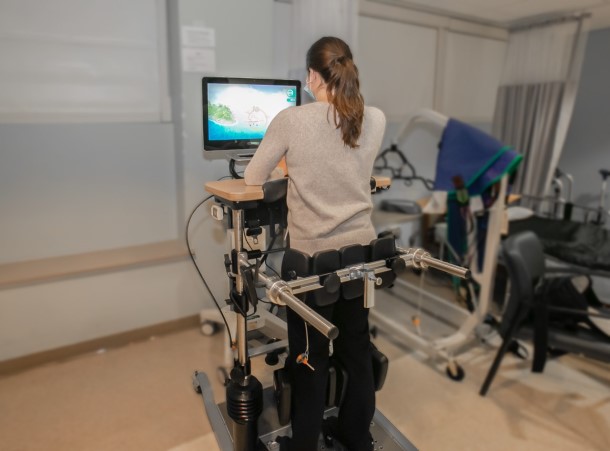
MossRehab presents a three-part series on therapeutic gaming in physical rehabilitation. In part one, we explain gaming theory and how it is taking physical rehabilitation to a new level with augmented and virtual reality games that create more engaging therapy activities.
Video games are entertaining and fun, captivating us in exciting challenges that provide satisfaction in conquering them. Therapeutic gaming uses the principles of video games to enhance therapy practices with rehabilitation equipment that features computer-based and/or virtual reality images. Patients work harder and longer on rehab equipment that incorporates an interactive gaming element.
Physical rehabilitation is critical after a stroke, brain injury, or surgery to improve an individual’s chances of recovering from injury and regain functional and cognitive abilities. But it can be hard. For the best outcomes, therapies rely on sustained and repetitive practice to retrain cognitive and motor skills.
For example, a patient who experienced a stroke may need a rehabilitation program to treat weakness of the arm or address walking difficulties. “After a stroke or brain injury, the neural pathways involved with the brain are interrupted,” explains Amanda Rabinowitz, PhD, institute scientist and director of the Brain Injury Neuropsychology Laboratory at the Moss Rehabilitation Research Institute (MRRI). “Repeated therapy exercises help to strengthen that pathway in the brain or develop a new one to restore function.”
It takes thousands of repetitions to make changes to the brain to recover higher levels of function. However, maintaining patient enthusiasm in traditional therapies is difficult. While therapists are very supportive in engrossing patients in exercises, individuals sometimes become tired and lose their drive in completing the same routines repeatedly.
The process of gamification or “therapeutic gaming” provides the stimuli and motivation to keep patients more engaged in rehab exercises. “If an activity is fun and engaging, a person is going to work harder and longer to maximize their performance,” notes Dr. Rabinowitz. “Games provide that extra motivation to achieve something, even if it’s just earning points or going to the next level.”
Therapeutic gaming motivates through rewards
Therapeutic game developers are tapping into how our brains give us a boost every time we receive a reward. So, a patient won’t stop a computer-based exercise until completing a certain number of repetitions to get that reward. This motivation helps maximize patient efforts during physical rehabilitation.
In addition, therapeutic gaming helps individuals to better understand and visualize exercise goals. “If somebody is working on their arms with a reaching exercise, therapy equipment with gamification can project an image, such as a fruit, to frame how to retrieve it,” Dr. Rabinowitz states. “Using this type of visualization helps patients to master the right movement for more natural motions. It would be hard to duplicate that motion by following a worksheet that outlines the exercise.”
Gaming therapy also provides immediate, robust feedback. Flashing lights and noise triggered when a patient makes the right movement encourages them to keep going. At the same time, therapists get information on patient progress to determine if they should level up or move to another activity.
Besides, the games offer a story element for greater immersion into exercises. For example, one virtual reality tool for gait rehab simulates situations that mimic real-world scenarios on video while the person walks on a treadmill. In one exercise, a patient may navigate a village while collecting ingredients to make pizzas and avoiding obstacles on the walking path. The virtual reality aspect makes for a multi-dimensional experience that stimulates the senses, mind, and body.
In addition to supporting fine motor movement in inpatient and outpatient therapies, therapeutic gaming serves in cognitive and emotional treatments. “Many individuals experience mood and stress issues or are less motivated in engaging in normal activities after brain injury,” says Dr. Rabinowitz. “Gaming therapy can help this population become interested in activities and meet defined goals as they receive feedback or a reward for their progress.”
Therapy games for home use
Gaming therapy often includes sensor technology that detects if a patient is moving correctly so the robot can assist in the movement. The sensors also monitor performance to provide feedback to both patients and therapists. “A remote gaming therapy tool on the market for motor recovery features hand-held discs that look like hockey pucks to exercise hands, arms, core, or legs. Sensors provide immediate and long-term feedback on performance to improve recovery,” Dr. Rabinowitz remarks. “These types of remote therapy devices fill the gap in continuing exercises at home to supplement outpatient rehabilitation.”
Smartphone applications also offer opportunities for remote rehabilitation. A phone app called SuperBetter offers mindset and psychological games that simulate real-life to overcome tough situations. Focused on cognitive recovery, the games increase resilience, mental health, and social skills for personal growth.
The development of gaming therapies for home use will help patients achieve health goals on their own. “Self-management is critical to recovery from brain injury and other neurologic conditions as people have difficulties with sleep, weight, physical activity, and depression,” notes Dr. Rabinowitz. “An application with gamification features that enables patients to set goals, make plans and monitor progress and keep users motivated can help maximize progress to achieve long-term goals.”
MossRehab currently has more than 25 robotic devices that its clinicians use during inpatient and outpatient rehabilitation at its physical rehabilitation. Many incorporate gaming therapies. For instance, the C-Mill features virtual reality (VR) in gait rehabilitation while the Tyromotion robot collection uses interactive games and VR to motivate patients in arm or leg exercises. MRRI also is working with innovators of gaming therapy to introduce new therapies.
In part two of our series, we will explore the various rehabilitation robotic devices with therapeutic gaming used at MossRehab.
Read Therapeutic Gaming Part 2: Clinical Use and Therapeutic Gaming Part 3: Leading the Future now.